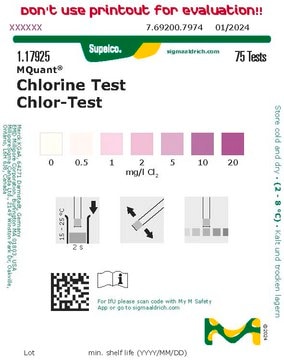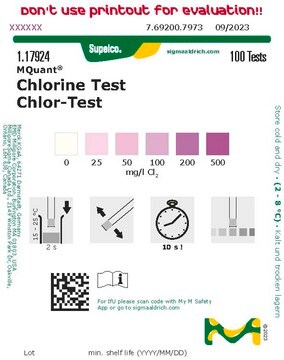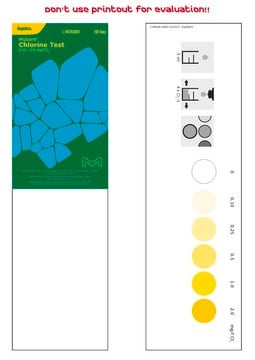1.14978
Chlorine Test Kit, colorimetric
0.1-2.0 mg/L (Cl₂), MQuant®
Synonym(s):
Chlorine Visual Test Kit
About This Item
Recommended Products
product name
Chlorine Test, colorimetric, 0.1-2.0 mg/L (Cl2), for use with MQUANT®
product line
MQuant®
Quality Level
specific analyte(s)
chlorine
measuring range
0.1-2.0 mg/L (Cl2)
compatibility
for use with MQUANT®
detection method
colorimetric
storage temp.
15-25°C
General description
The test can be used in
- Groundwater and surface water
- Drinking water and mineral water
- Waters from aquaculture
- Wastewater
- Electroplating wastewater
- Disinfectant solutions
This test is not suited for seawater.
Method
In weakly acidic solution free chlorine reacts with diethyl-p-phenylenediamine (DPD) to form a red-violet dye. In the presence of potassium iodide, also combined chlorine is measured in this reaction. The chlorine concentration is measured semiquantitatively by visual comparison of the color of the measurement solution with the color fields of a color disk.
The test evaluates the color reaction based on the transmitted light method. So even turbid and colored water samples can be analyzed without further preparation.
The color disk is made of very durable, lightfast plastic, thus suitable for industrial areas and wet environments.
Using the refill pack 1.14979 containing all the reagents, the original test kit can be used for a very long time, making it a particularly economical and ecological system.
Application
- Water Treatment and Disinfection: Chlorine testing is crucial for ensuring the safety and effectiveness of water disinfection processes. Accurate measurement of free chlorine and total chlorine levels is essential to maintain appropriate disinfection while minimizing the formation of harmful disinfection by-products (DBPs). Recent studies have focused on the kinetics of chlorine reactions in seawater and their impact on biocidal effectiveness and environmental safety (Kinani et al., Critical Reviews in Analytical Chemistry, 2022).
- Environmental Monitoring: Chlorine testing is used to monitor chlorine levels in various environmental matrices, such as rivers, lakes, and wastewater. This is essential to assess the impact of chlorination on aquatic ecosystems and to ensure compliance with environmental regulations. Advanced chromatographic and mass spectrometric techniques are employed to speciate chlorine-produced oxidants and their by-products in seawater (Roumiguières et al., Critical Reviews in Analytical Chemistry, 2023).
- Public Health and Drinking Water Safety: Ensuring the safety of drinking water is a primary concern. Chlorine testing helps to maintain the right balance of chlorine for effective pathogen control while avoiding excessive chlorination that could lead to health risks. Analytical methods, including titrimetric and colorimetric methods, are used to measure residual chlorine in drinking water to ensure it meets safety standards (Ko et al., Chinese Journal of Analytical Chemistry, 2022).
- Industrial Applications: Chlorine testing is essential in various industrial processes where chlorine is used, such as in the production of paper and textiles, and in cooling water systems. Accurate monitoring of chlorine levels helps in optimizing these processes and ensuring compliance with safety and environmental regulations (Kinani et al., Critical Reviews in Analytical Chemistry, 2022).
- Photochemical Degradation Studies: Chlorine testing is also used in research studies involving the photochemical degradation of pollutants. For example, the use of UV/free chlorine processes in degrading pharmaceuticals in aqueous solutions has been investigated using response surface methodology to optimize conditions for maximum efficiency (Arman et al., International Journal of Environmental Analytical Chemistry, 2022).
Legal Information
Signal Word
Danger
Hazard Statements
Precautionary Statements
Hazard Classifications
Eye Dam. 1 - Met. Corr. 1 - Skin Corr. 1A
Storage Class Code
8A - Combustible, corrosive hazardous materials
WGK
WGK 2
Certificates of Analysis (COA)
Search for Certificates of Analysis (COA) by entering the products Lot/Batch Number. Lot and Batch Numbers can be found on a product’s label following the words ‘Lot’ or ‘Batch’.
Already Own This Product?
Find documentation for the products that you have recently purchased in the Document Library.
Customers Also Viewed
Protocols
Preparation of a standard solution for free Chlorine according to DIN EN ISO 7393
Related Content
AQA Standard for free chlorine - Preparation of a standard solution for free chlorine
Our team of scientists has experience in all areas of research including Life Science, Material Science, Chemical Synthesis, Chromatography, Analytical and many others.
Contact Technical Service















